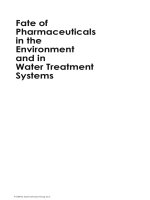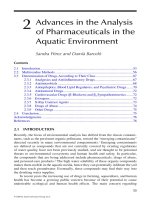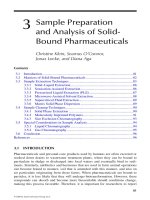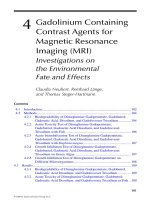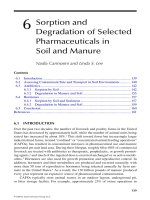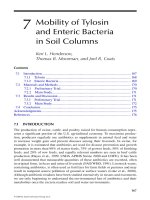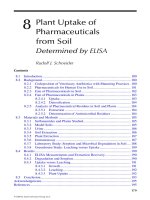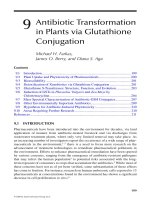Lecture Economic development - Chapter 10: The environment and development
Bạn đang xem bản rút gọn của tài liệu. Xem và tải ngay bản đầy đủ của tài liệu tại đây (390.21 KB, 30 trang )
Chapter 10
The Environment
and Development
Copyright © 2009 Pearson Addison-Wesley. All rights reserved.
Economics and the Environment
• Environmental issues affect, and are
affected by, economic development
• Poverty and ignorance may lead to nonsustainable use of environmental resources
• Environmental decay and global warming
are serious issues we face today
Copyright © 2009 Pearson Addison
Wesley. All rights reserved.
102
National Income Accounting
• GDP (or GNI) is the market value of final
goods and services
• GDP (or GNI) excludes the externalities of
production and consumption
– Negative externalities: costs imposed on the
environment and third parties; e.g., air pollution,
land contamination
Copyright © 2009 Pearson Addison
Wesley. All rights reserved.
103
Reasons for Environmental Decay
• The common property right over the
environment
– No one has private property rights over the
environment being polluted (e.g., air, ocean
water)
• The collectively consumed nature of the
environment
– Benefits received by all users
– No one can be excluded from using it
Copyright © 2009 Pearson Addison
Wesley. All rights reserved.
104
Adjustment for Environmental Decay
• To adjust for the negative externalities find
the “sustainable” Net National Income as
NNI* = GNI – Dm – Dn – R – A where
– Dm = depreciation of physical capital
– Dn = depreciation of environmental capital
– R = expenditures required to restore environmental
capital
– A = expenditures required to avert destruction of
environmental capital
Copyright © 2009 Pearson Addison
Wesley. All rights reserved.
105
Causes of Environmental
Decay
•
•
•
•
•
•
•
Poverty
Rapid population growth
Rapid urbanization
Affluence & excess consumption
Industrial production
Use of chemical inputs
Relaxed environmental laws and weak law
enforcements
Copyright © 2009 Pearson Addison
Wesley. All rights reserved.
106
Poverty and Environment
• Poverty and lack of development policies
would force the people to overuse natural
resources:
– Cultivate the land without fertilization
– Cut the trees for fuel
– Contaminate the water
– Pollute the air
Copyright © 2009 Pearson Addison
Wesley. All rights reserved.
107
Population Growth and
Environment
• Rapid population growth put pressure on
natural resources:
– Clean air
– Arable land
– Safe drinking water
– Forests
– Mineral deposits
Copyright © 2009 Pearson Addison
Wesley. All rights reserved.
108
Urbanization and Environment
• Rapid urbanization and relaxed
environmental laws result in environmental
degradation:
– Air pollution from fossil fuel consumption
– Congestion and noise pollution
– Water contamination
– Relaxed emission control policies
Copyright © 2009 Pearson Addison
Wesley. All rights reserved.
109
The Global Environment
• Consumption patterns of the very poor and very rich
• Global warming and rising sea level
• Rapid population growth, poverty, and income
inequality in LDCs
• Rapid deforestation due to pollution and commercial
development
• Rapid desertification due to lack of rural development
Copyright © 2009 Pearson Addison
Wesley. All rights reserved.
1010
Private Property Rights
Perfect private property rights require:
• Universality: all resources are privately owned
• Exclusivity: owner prevents others from using
resources
• Transferability: owner can sell resources when
desired
•Copyright © 2009 Pearson Addison
Enforceability: owner receives all benefits
Wesley. All rights reserved.
1011
Environment and Development:
The Basic Issues
• Sustainable development and
environmental accounting
• Population, resources, and the environment
• Poverty and the environment
• Growth versus the environment
• Rural development and the environment
Copyright © 2009 Pearson Addison
Wesley. All rights reserved.
1012
Private Property Rights
Perfect private property rights require:
• Universality: all resources are privately owned
• Exclusivity: owner prevents others from using
resources
• Transferability: owner can sell resources when
desired
• Copyright © 2009 Pearson Addison
Enforceability: owner receives all benefits
Wesley. All rights reserved.
1013
Economics of the Environment
Free market transactions achieve stable
equilibrium, benefiting
• Consumer through the creation of a
consumer surplus
• Producers through the creation of a
producer surplus
Copyright © 2009 Pearson Addison
Wesley. All rights reserved.
1014
Economics of the Environment
Supply
Price
Consumer Surplus
Marginal Cost
P
Producer Surplus or Scarcity Rent
Demand
Q
Copyright © 2009 Pearson Addison
Wesley. All rights reserved.
Quantity
1015
Optimal Resource Use
Resource conservation results in a
• Higher future price
• Greater producer surplus
Copyright © 2009 Pearson Addison
Wesley. All rights reserved.
1016
Optimal Resource Use
Price
Ps
P
By reducing consumption from 75 to 50, price goes
up to PS and producer surplus increases by PSPab
a
MC
b
Demand
50
75
Copyright © 2009 Pearson Addison
Wesley. All rights reserved.
Quantity
1017
Common Property Rights
• When a scarce resource (e.g., land) is
publicly owned and thus freely available to
all users (e.g., farming or grazing animals)
• Any potential benefit (i.e., producer surplus
or scarcity rent) will be competed away as
more people use the resource
Copyright © 2009 Pearson Addison
Wesley. All rights reserved.
1018
Common Property Rights
Initial employment is L*, where MPL = W and PS =
AP*CDW.
As more workers use the land, MPL < W and PS declines.
At LC, MPL is very small, AP = W, and PS = 0
Return to labor
AP*
C
W
D
E
Wage
Marginal Product of Labor
Average Product of Labor
L*
Lc
Copyright © 2009 Pearson Addison
Wesley. All rights reserved.
No. of Workers
1019
Public Goods and Environment
Public or collectively consumed good
• Provides benefits to all users
• Its availability won’t diminish as others use it
simultaneously
• Is produced by the government
• Is subject to the “free-rider” problem
The human environment is collectively consumed.
Copyright © 2009 Pearson Addison
Hence,
it is subject to decay.
Wesley. All rights reserved.
1020
Demand for Public Goods
• Aggregate demand is the “vertical”
summation of individual user demands
• Cost of providing the good to the society is
greater than the individual users’ costs
Copyright © 2009 Pearson Addison
Wesley. All rights reserved.
1021
Demand for Public Goods
A+B
Price
Q* = Qa + Qb; Pa < Pm; Pb < Pm
B
Aggregate Demand
A
c
Pm
Pb
b
MC
Aggregate Supply
a
Pa
Qa
Qb Q*
Copyright © 2009 Pearson Addison
Wesley. All rights reserved.
Quantity
1022
Negative Externalities
• When consumption or production inflicts
damages on third parties (e.g., air pollution
generated by using private automobiles)
• The good whose production pollutes the
environment is over-produced, but underpriced if producers do not pay for the
cleaning cost
Copyright © 2009 Pearson Addison
Wesley. All rights reserved.
1023
Negative Externalities
Price
MCS
MCP
a
P*
PM
PC
Supply
b
DeadWeight Loss = abc
c
Demand
Q*
QM
Quantity
MCS>MCP: QM > Q* and PM < P* where Q* and P* = “socially optimum”
price and quantity; QM and PM = “market” price and quantity
Copyright © 2009 Pearson Addison
Wesley. All rights reserved.
1024
Environmental Decay
• As the demand for the good increases due
to
– Economic growth
– Population growth
• The “market” price and quantity will further
diverge from the “socially optimum” price
Copyright © 2009 Pearson Addison
and quantity
Wesley. All rights reserved.
1025

